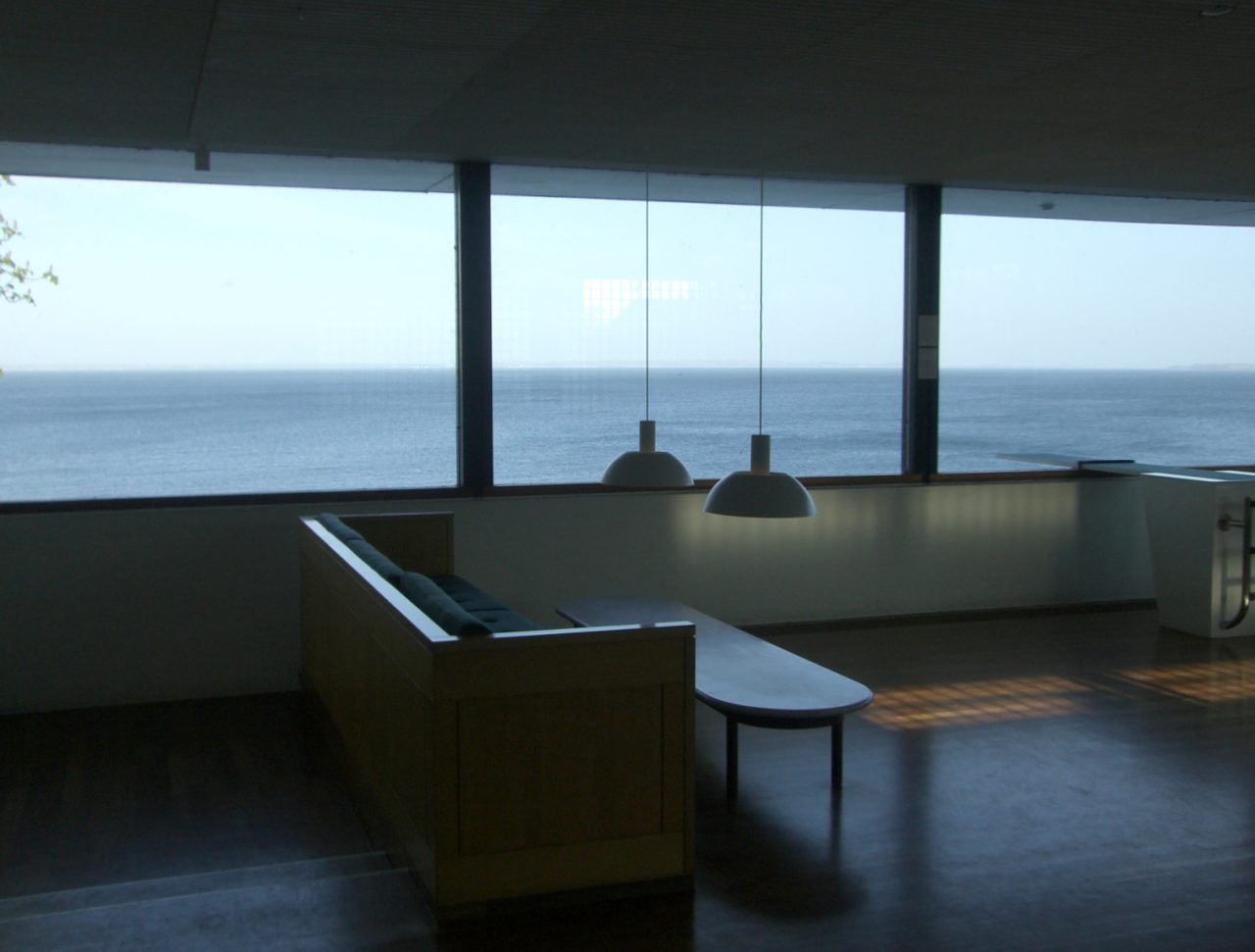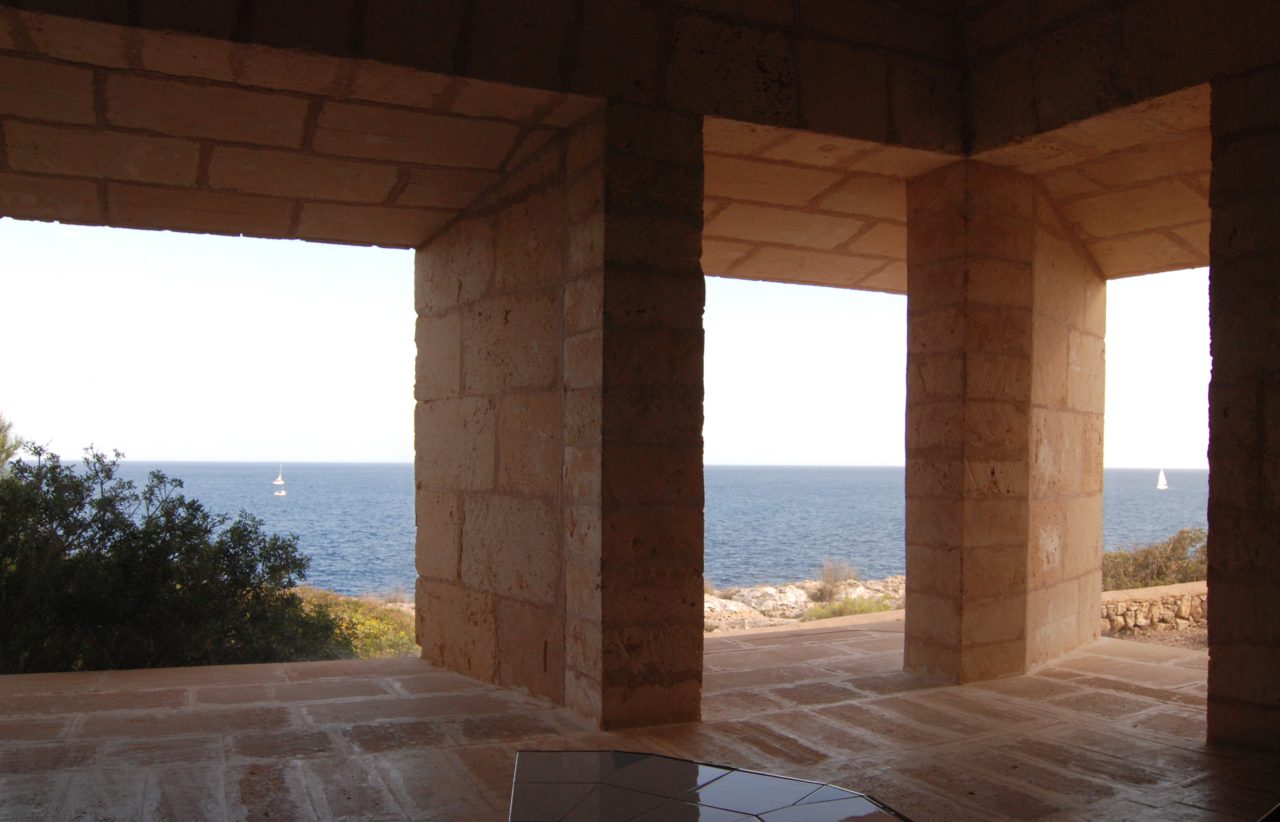
Part 2: Apertures for View
18 Oct 2017
Apertures have many purposes of uses. They are used as light sources, as ventilation, and as portals through which people pass. In each of these examples, they are opened to allow some physical thing to pass through them. However, apertures do exist for different purposes. Windows that use the translucency of glass in order to provide a line of sight to the outside from the inside, in other words, apertures that have been installed to allow one to enjoy the scenery, are one such example. Since they are not intended to be physically opened or closed, some of them are fixed windows.
1.”Windows that frame” – Cropping the View
1-1. Art Museum
If someone ask me, “What is your favorite art museum in the world?” I will no doubt answer “The Louisiana Museum of Modern Art.” One of my favorite spaces in this museum is this exhibit room. The position of Giacometti’s sculpture never changes. What do change are the pictures on the walls and the scenery over the window. The view is framed so that it is just like a gigantic painting. Depending on the season, time of day, or weather, the scenery changes so that no matter when you go, it moves you and brings you joy. The “Walking Man”(Giacometti’s sculpture) is frozen in time for all eternity, but the scenery behind him is constantly changing.
-

Vilhelm Wohlert and Jørgen Bo’s "Louisiana Museum of Modern Art" (built in 1958 in Denmark)
Here you can see a long set of windows that line up perfectly with the horizon. You can also see the diving board (right side) that stick out from inside to outside. If it weren’t for the diving board, which is a form of modern art, one would feel like they were in the living room of a coastal house. Now that I think about it, this art museum was repurposed from a residence. One could say that this is a reproduction of a personal space, the purpose of which is to allow one to take a moment to rest between viewing art exhibits. This is also one of my favorite spaces.
-

Vilhelm Wohlert and Jørgen Bo’s "Louisiana Museum of Modern Art" (built in 1958 in Denmark)
1-2. Residence
The Danish architect Jørn Utzon built a private house named “Can Lis” atop the cliffs of an island in Spain called Majorca. One of its characteristics is the fact that every room has apertures through which one can gaze out at the horizon. The pictures make it look as though there is no glass in them, but that is not the case. Utzon designed them with the view from inside, so the wooden frames that hold the glass are attached to the outside walls. The back of the windows taper inwards and make use of perspective, acting as frames that direct the gaze of those inside outward. The positions of the plants outside were all decided based on the view from the inside. Of particular note are the five windows of the living room, which are each angled differently, cutting out a distinct view of the Mediterranean that lies just outside. When one sits in the long curved chair in the room, depending on where they sit the window that sits directly before them changes, but regardless of the where they sit, five different scenes become visible to them simultaneously, such that they feel as though they are viewing five different movie screens.
-

Jørn Utzon’s "Can Lis" (built in 1972 in Spain)
-

The Living Room Windows of "Can Lis" (built in 1972 in Spain)
Next, let’s take a look at the Finnish architect, Alvar Aalto’s own house, where a living space for his family is designed so that it lies directly next to his work space. Aalto’s work desk faces a corner window through which one can gaze at the green of the tall trees that grow freely outside. One can imagine that he could do the detailed kind of work that building design entails with a calm state of mind in this kind of environment.
-

Alvar Aalto’s Own House, "The Aalto House" (built in Finland in 1936)
1-3. Church
Sometimes one wants to display man-made objects rather than the natural environment over the window. In Finland “Otaniemi Chapel” there is a window put in specifically for the purpose of viewing a cross. Just beyond where the window is embedded a simple cross stands. When I visited the chapel snow was scattered outside so the scene with the trees flanking the cross looked quite cold. The people that came to pray at the chapel sat in chairs and faced the cross. Glass was laid between a comfortable human scale indoor space and the cross, which was positioned at just the right distance from the building. The glass of the window was fixed, creating a “barrier” that separated the holy region beyond, into which humans are forbidden to step.
-

Kaija and Heikki Siren’s "Otaniemi Chapel" (built in Finland in 1957)
2. “Liberating Windows” – Landscapes that Stretch Outwards
2-1. Residence
Danish architect Jørn Utzon designed a house where one can appreciate nature from the living space, which is raised above the ground. This residence named “Middelboe House”, known as “The Stilt House” because of the characteristic shape, is held up by a steel frame so that one can overlook the small river that flows through the corner of the garden to the nearby lake. The apertures, which are all lined up in succession, are fixed windows, and when one opens the curtains, one can gaze at 180 degrees of magnificent natural landscape. The couple who lives there enjoys the scenery of all four seasons throughout their daily lives.
-

Jørn Utzon’s "Middelboe House" (built in 1955 in Denmark)
2-2. Art Museum
As an example of windows that connect the spaces of inside and outside, I’d like to show the windows of the “Viking Ship Museum,” which were designed to display ships. Beyond the museum’s long windows one can see a vast ocean. If you look at the ship from just in front of it, it looks as though the ship has come back to life and is floating on the sea. Indeed, the ship did once float across the very waters that lay outside the window.
-

Erik Christian Sørensen’s "Viking Ship Museum" (built in 1997 in Denmark)
If you want to enjoy a vast panoramic view, then you might want to climb up to the observation deck of “Museum of Southern Jutland.” It was originally a water tower that was built in 1902. It was repurposed in 1995 as a museum for Hans Wegner’s chairs. The top of the museum was made into an observation room from which you can experience a 360 degree panoramic view.
-

Niels Truelsen’s repurposed "Museum of Southern Jutland" (built in 1995 in Denmark)
Landscapes viewed through apertures. They are various, and might feature a portion of the landscape cropped for viewing, or a vast landscape in which one can see the horizon. In such cases, the architect consciously goes out of their way to create a space indoors in which one can enjoy the “beautiful natural landscape.” They share the common characteristics that they are made to bring enjoyment to one’s eyes and make life richer. Large panes of glass, which were increasingly used in the 20th century, have been instrumental in such creations, making these “visual treats” possible.
Nahoko Wada
Nahoko Wada was born in Niigata prefecture, and received her Ph.D. from Keio University’s Graduate School of Media and Governance. She has worked at The Museum of Modern Art, Kamakura & Hayama, Copenhagen University, Tohoku University of Art and Design, Tokyo University of the Arts, and Keio University. Her specialities are the history of modern Japanese and Scandinavian residential architecture. She published several books include “Water Usage Spaces and Equipment in Modern Japanese Houses,” (Kindai nippon no mizu-mawari) “Modern Houses in Scandinavia,” (Hoku’ou modan hausu) “Arne Jacobsen,” (the above published by Gakugei Publishing) and “Travel Essay on Scandinavian Architecture” (published by Yamakawa Publishing). She established, “Access Point: Architecture-Tokyo” in October of 2016.











